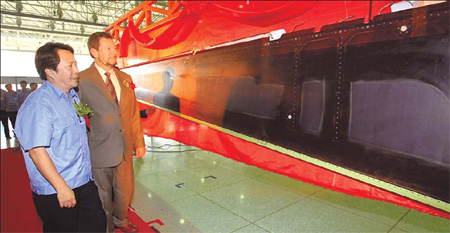Companies
Airbus Harbin JV plant delivers 1st work package
By HU YANG and LU HAOTING (China Daily)
Updated: 2010-07-03 09:21
 |
Large Medium Small |
|
 |
|
Laurence Barron (right), president of Airbus China, and Liu Guanglin, chairman of Harbin Hafei Airbus Composite Manufacturing Center, attend the delivery ceremony and unveil the first work package of A320 elevators in Harbin, Heilongjiang province. The manufacturing center will start producing components for the A350 from the first half of 2011. [Provided for China Daily] |
HARBIN/BEIJING - European aircraft producer Airbus' composite manufacturing center in the northeastern city on Friday delivered its first work package, a set of A320 elevators, and will start to produce components for the company's latest A350 from the first half of 2011.
The factory, Harbin Hafei Airbus Composite Manufacturing Center, started production at the end of 2009 with single-aisle A320 aircraft work packages, including elevators, rudders and horizontal tail plane spars.
Airbus holds a 20 percent stake in the center, while a Chinese consortium, including subsidiaries of Aviation Industry Corp of China (AVIC) and the local government, control the remaining stakes.
The joint venture was established as part of Airbus' commitment to manufacture 5 percent of the A350 airframe in China under an agreement reached in 2007 with the Chinese government. The center is an exclusive supplier for A350 rudders, elevators and maintenance doors. Production of these parts will start in the first half of 2011 after the initial industrialization phase is completed in Europe, said Laurence Barron, president of Airbus China.
| ||||
Currently the joint venture has 51 employees, with the number expected to reach 100 by the end of the year.
Barron said Airbus will soon announce the allocation of two more A350 work packages, namely spoilers and belly fairings, to Chinese aviation manufacturers. By then the allocation of the 5 percent of airframe work packages to China will be completed. But Barron told China Daily earlier that Airbus' Tier-1 suppliers may also subcontract work to China in the future if Chinese manufacturers can offer competitive prices.
The A350 is due to enter service in 2013. China signed a letter of intent in 2006 to buy 20 A350s. Airbus had received 505 orders by the end of March.
The A350 is Airbus' answer to the runaway success of US rival Boeing's B787, which has received 860 orders, in the market for long-range, twin-aisle planes. The first delivery is scheduled by the end of 2010.
Both the B787 and the A350 use a huge amount of composite materials for the airframes as the light weight materials have better fatigue and corrosion resistance along with higher strength-weight ratios. The B787 is the first major aircraft to use composite materials for most of its construction, while the A350 will be the first Airbus aircraft with its fuselage and wing structures manufactured primarily from composite materials.
Boeing also has a composite material manufacturing joint venture in Tianjin, in which the US company controls 88 percent of the stakes and AVIC holds the remaining stakes.



